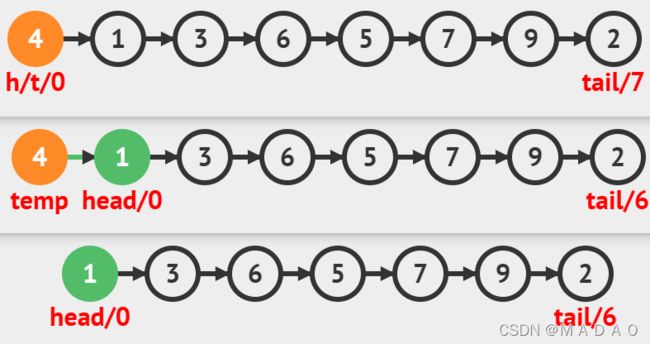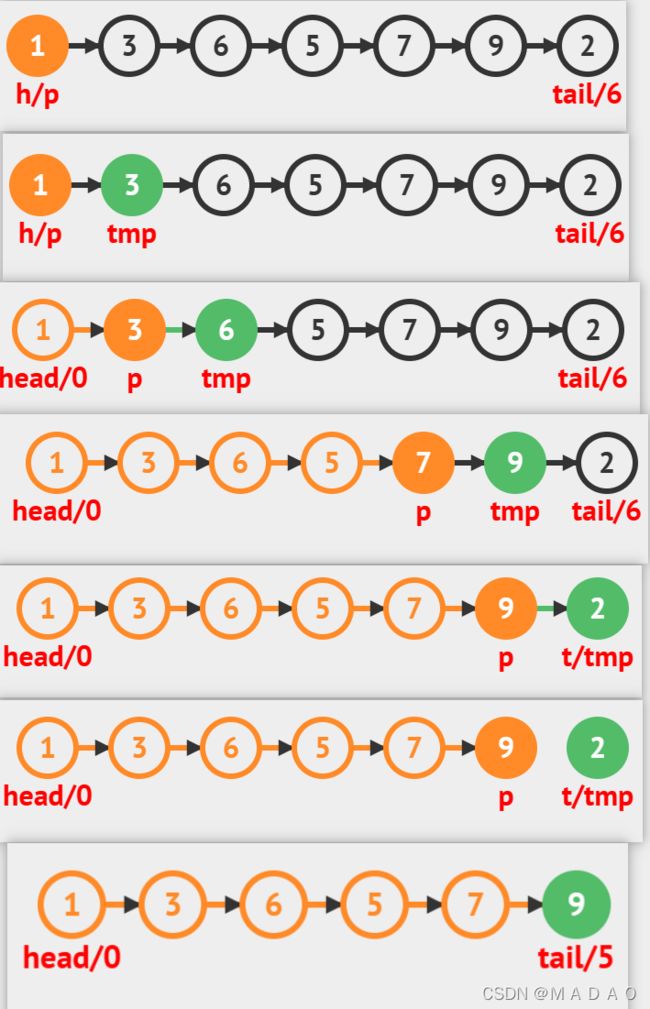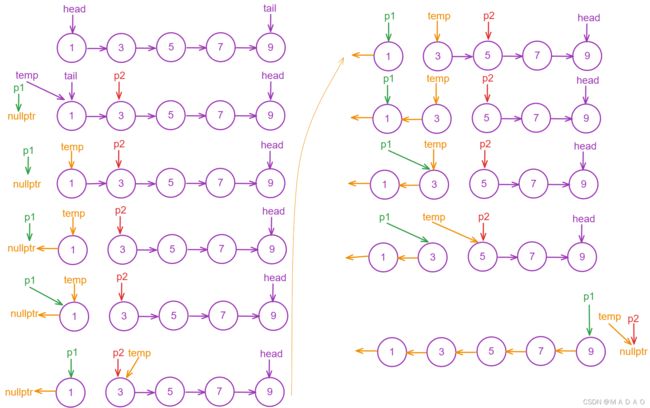基于面向对象编程,C++实现单链表
链表:在内存空间中是非连续存储
组成:链表是由一个个节点组成的,每个节点都包含两个元素:数据和指针

节点头文件:
建立一个ListNode.h头文件
#pragma once
class ListNode
{
public:
int value;
ListNode* next;
ListNode(int val);
~ListNode();
};
节点源文件:
建立一个ListNode.cpp源文件
#include "ListNode.h"
ListNode::ListNode(int val)
{
this->value = val;
next = nullptr;
}
ListNode::~ListNode()
{
}
单链表:由一个个节点组成:
链表头文件:
建立一个ListNode.h头文件,将需要的API函数写入其中
#pragma once
#include "ListNode.h"
class LinkList
{
public:
ListNode* head;
ListNode* tail;
int length;
LinkList();//默认构造
~LinkList();//默认析构
LinkList(int val);//有参构造
void GetLength();//获取长度
void PrintList();//打印链表
ListNode* get(int index);//获取元素
void append(int val);//尾部添加元素
void prepend(int val);//头部添加元素
void insert(int index, int val);//插入元素
ListNode* removeFirst();//移除头部元素
ListNode* removeLast();//移除尾部元素
ListNode* remove(int index);//移除元素
void reverse();//链表翻转
bool set(int index, int val);//修改元素
int search(int val);//查找元素
};
链表源文件
建立LinkList.cpp源文件,实现具体的API
#include测试文件:
建一个单链表.cpp文件,用一个例子进行测试
#include插入元素:
- 头部插入:
由图可以知道,在头部插入时,先将新节点的next指向头结点,然后再将头结点移动到新节点处:
//头部增加元素
void LinkList::prepend(int val)
{
ListNode* newNode = new ListNode(val);//创建新节点
if (length == 0) {//如果单链表为空,就将单链表的头结点和尾节点都指向新节点
head = newNode;
tail = newNode;
}
else {
newNode->next = head;
head = newNode;
}
length++;
}
- 尾部插入:
在进行尾插时,先将尾节点的next指向新节点,然后尾节点移动到新节点上
//尾部增加元素
void LinkList::append(int val)
{
ListNode* newNode = new ListNode(val);
if (length == 0) {
head = newNode;
tail = newNode;
}
else {
tail->next = newNode;
tail = newNode;
}
length++;
}
- 其他位置插入:
在任意位置插入节点时,有以下几种情况:
1.如果插入的位置不合法要求,返回false
2.如果index=0,头插法
3.如果index=length-1,尾插法
4.其他情况下,
(1)先创建一个临时节点pre令其指向头结点head,
(2)然后移动pre指向index处前的一个节点
(3)在创建一个节点aft指向index
(4)让新节点的next指向aft
(5)让pre节点的next指向新节点
//插入元素
void LinkList::insert(int index, int val)
{
if (index<0 || index>length) {
cout << "error";
}
else if (index == 0) {
prepend(val);
}
else if (index == length - 1) {
append(val);
}
else {
ListNode* pre = head;
for (int i = 0; i < index - 1; i++) {
pre = pre->next;
}
ListNode* aft = pre->next;
ListNode* newNode = new ListNode(val);
newNode->next = aft;
pre->next = newNode;
length++;
}
}
删除元素:
- 头部节点删除
(1)创建一个新节点指向head
(2)让head向后移一个,即head指向head的next节点
(3)然让temp的next指向head
2. 尾部节点删除
(1)先创建两个节点:tmp和pre指向head
(2)依次向后移动temp和pre
(3)tail节点指向pre所指的节点
(4)tail的next指向nullptr
3. 任意位置删除
1.判断index是否合法,不合法返回false
2.如果index=0,则头结点删除法
3.如果index=length-1,则尾节点删除法
4.如果任意位置,则:
(1)创建一个节点prev指向头结点head
(2)移动pre节点至index的前一个节点
(3)创建一个节点temp指向prev的next节点即index指向的节点
(4)让prev的next节点指向temp的next节点
(5)temp的next指向空
修改元素:
(1)获取该节点
(2)如果该节点不为空,将新值赋给该节点的值
//修改元素
bool LinkList::set(int index, int val)
{
ListNode* temp = get(index);
if (temp) {
temp->value = val;
return true;
}
return false;
}
查找元素:
(1)创建一个临时节点temp,指向头结点head
(2)依次移动temp,并判断temp是否为空
(3)找到节点并返回相应的索引
//查找元素
int LinkList::search(int val)
{
int index = 0;
ListNode* temp = head;
while (temp->value != val) {
index++;
temp = temp->next;
if (temp == nullptr) {
cout << "未找到!" << endl;
return -1;
}
}
//cout<
return index;
}
链表反转:
1.创建一个节点temp,指向头结点head
2.头结点和尾节点互换位置
3.创建两个节点:p1指向空,p2指向temp的下一个节点
4.在整个单链表上进行如下操作:
(1)p2指向temp的下一个节点
(2)然后temp的next指向p1
(3)p1移动至temp
(4)temp移动至p2
//链表反转
void LinkList::reverse()
{
ListNode* temp = head;
head = tail;
tail = temp;
ListNode* after = temp->next;
ListNode* before = nullptr;
for (int i = 0; i < length; i++) {
after = temp->next;
temp->next = before;
before = temp;
temp = after;
}
}









